Salinity Management Guide
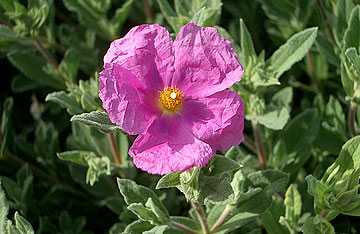
Cistus creticus (rock rose) is thought by some to be salt-tolerant.
How to select salt-tolerant plants
For a landscape irrigated with water of elevated salinity, a crucial part of assessing biological criteria involves checking the tolerances to salinity of species under consideration.
Here's how to choose species that have an appropriate degree of salt tolerance for a particular landscape:
Step 1: Familiarize yourself with the salinity-related parameters of your landscape's irrigation water and soil.
For water, the parameters to consider include the sodium ion (Na+), chloride ion (Cl-), boron (B), bicarbonate ion (HCO3-), and carbonate ion (CO32-) contents; the total concentration of soluble salts, typically measured as total dissolved solids (TDS) or as electrical conductivity of the irrigation water (ECiw); the pH; and the sodium absorption ratio (SAR), which is the relative proportion of sodium ion to calcium ion (Ca2+) and magnesium ion (Mg2+).
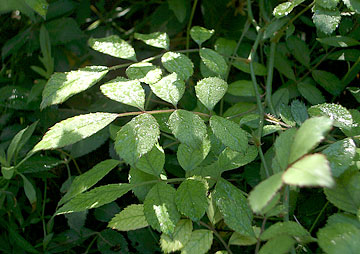
Checking the irrigation water’s salinity is a good idea, particularly if the water makes contact with plants’ leaves.
For soil, relevant parameters include the sodium ion (Na+), chloride ion (Cl-), boron (B), and ammonium (NH4+) contents; the sodium absorption ratio; and the soil's electrical conductivity (ECe). The latter is determined by saturating one or more samples of soil with distilled water, extracting the resulting solutions, and measuring the solutions' electrical conductivities.
To obtain salinity-related parameters for irrigation water, either ask for a report from your water provider or submit samples of the water to a commercial analytical laboratory. To obtain the pertinent parameters for soil, collect samples and submit them to a commercial analytical laboratory. For tips on collecting and transporting samples, contact the laboratory or laboratories you plan to use.
Step 2: Once you have in hand the reports from the water and soil analyses, scan for and note the salinity-related parameters.
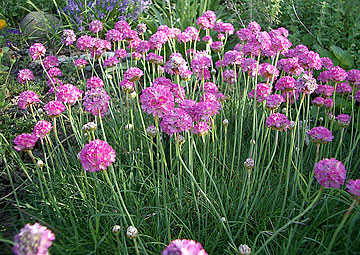
Determining the salinity of irrigation water and of a landscape’s soil is advisable, since not all plants are as salt-tolerant as Armeria maritima (sea pink).
To make use of the findings provided later in this module's tables, you'll need the irrigation water's electrical conductivity in decisiemens per meter and its sodium, chloride, and boron contents in parts per million or milligrams per liter. You'll also need the soil's electrical conductivity in decisiemens per meter.
If the units on your water and soil reports differ from this, you'll need to convert the units from the lab reports, so that you can readily correlate them to the scientific findings.
Step 3: Convert units as needed.
Here's a quick guide to converting units:
- 1 part per million (ppm) = 1 milligram per liter (mg/L)
- 1 milligram per liter (mg/L) = milliequivalents per liter (meq/L) x the element's equivalent weight (e.g., 23 for sodium, 35 for chloride)
- 1 millimho per centimeter (mmho/cm) = 1 decisiemen per meter (dS/m) = 1,000 micromhos per centimeter (µmhos/cm) = 0.1 siemen per meter (S/m)
- Electrical conductivity of irrigation water (ECiw) approximately equals the total dissolved solids in parts per million or milligrams per liter divided by 640. That number 640 is an average conversion factor applicable under most circumstances (consult your testing laboratory if you're unsure about this). Stated another way, and using symbols:
TDS in mg/L or ppm = 640 × ECiw in dS/m
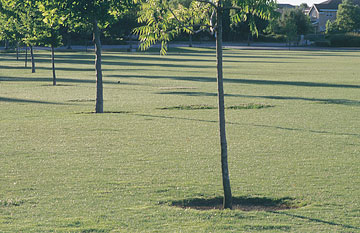
All except a few species of turfgrass are salt-tolerant.
Step 4: Check the scientific findings regarding salt tolerances of the plant species you are considering.
A caveat before proceeding: No standard definitions exist for the descriptive terms used to relate the relative tolerances of species to salinity. That's why, with each set of findings, it's important to go beyond the descriptive terms, such as "moderately sensitive," and find out the definitions of those terms, such as "tolerates salinity, expressed as the soil's electrical conductivity (ECe), in the range of 3 to 6 dS/m." Such definitions can usually be found in the report or article that describes the findings and sometimes in tables of data, either parenthetically or in footnotes.
To check the tolerances of species of turfgrasses, refer to the Table for turfgrasses. That table includes relatively recent findings compiled by several researchers.
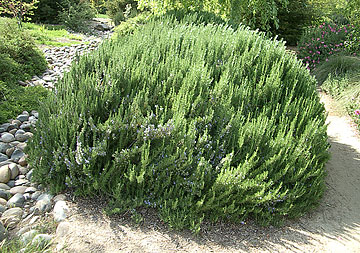
According to at least three studies, Rosmarinus officinalis (rosemary) is salt-tolerant, though the extent of tolerance remains a matter of debate.
To check the tolerances of species of plants other than turfgrasses, refer to the following tables. These tables include data from two of the most comprehensive and recent studies to date. Both studies were based on field research, combined with reviews of the scientific literature.
| « Previous page | Next page » |